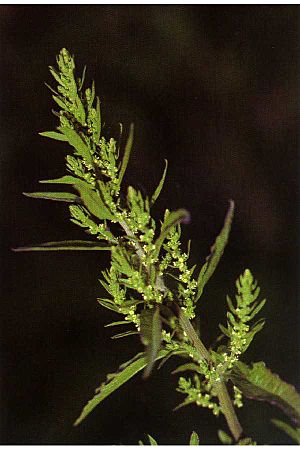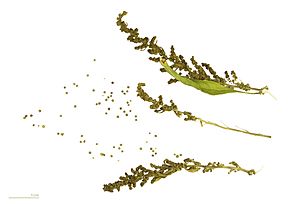Epazote facts for kids
Quick facts for kids Epazote |
|
|---|---|
 |
|
| Scientific classification | |
| Genus: |
Dysphania (plant)
|
| Species: |
ambrosioides
|
| Synonyms | |
|
|
Epazote (pronounced eh-pah-ZOH-tay) is a special herb. Its scientific name is Dysphania ambrosioides. People also call it Jesuit's tea or Mexican-tea. This plant is a type of herb that grows every year or lives for a few years. It comes from Central America, South America, and southern Mexico.
Contents
About Epazote
How it Grows
Epazote can grow up to about 1.2 meters (4 feet) tall. It has many branches and long, thin leaves. These leaves can be up to 12 centimeters (5 inches) long. The plant's flowers are small and green. They grow in a cluster at the top of the stem.
Besides its native homes, epazote also grows in warmer areas. You can find it in parts of Europe and the United States. Sometimes, it can spread very easily. When it grows where it's not wanted, it's called an invasive weed.
Plant Names and History
This plant was first described in 1753 by Carl Linnaeus. He was a famous scientist who named many plants. He called it Chenopodium ambrosioides back then. Now, scientists have changed its name to Dysphania ambrosioides. This change happened because they learned more about how plants are related.
The common Spanish name, epazote, comes from an old language. It comes from the Nahuatl word epazōtl. Nahuatl was spoken by the Aztec people in Mexico.
Using Epazote
Cooking with Epazote
Epazote is often picked before it makes seeds. People use its leaves as a leaf vegetable or a herb. It has a very strong and unique smell and taste. Some people say it tastes like oregano, anise, or even tarragon. It can also remind some people of turpentine or citrus fruits.
Epazote is a key ingredient in many traditional Mexican dishes. It is often used with black beans. It adds flavor and can help with digestion. You might find it in quesadillas and sopes. It's also used in soups, mole de olla, and tamales. Sometimes, it flavors eggs, potatoes, and enchiladas. It's also important for making green salsa for chilaquiles.
Is it Safe to Eat?
Epazote is safe to use in small amounts for cooking. However, its essential oils can be harmful in large amounts. These oils contain a chemical called ascaridole. If someone takes too much of the pure oil, it can cause stomach pain, vomiting, and diarrhea. That's why it's important to only use epazote in the small amounts found in recipes.
Other Uses for Epazote
Epazote has natural chemicals that can act like pesticides. These chemicals are called terpenes. Because of this, epazote can stop other plants from growing too close. So, it's best to plant it a little bit away from other garden plants.
Epazote can also be a companion plant. This means it helps other plants grow better. It can hide the smell of nearby plants from some insects. This makes it harder for pests to find them. Its small flowers can also attract helpful insects like wasps and flies. These insects can protect other plants from pests.
Chemicals in Epazote
Epazote contains a special oil called oil of chenopodium. This oil has a strong smell and taste. It was once used to treat certain health issues.
The main chemical in epazote's oil is ascaridole. This chemical gives epazote its strong flavor. Ascaridole is not very common in other spices. It can be a little bit toxic in large amounts. The amount of ascaridole can be different depending on where the epazote is grown. For example, epazote from Mexico usually has less ascaridole than epazote grown in Europe or Asia.
See also
 In Spanish: Epazote para niños
In Spanish: Epazote para niños


